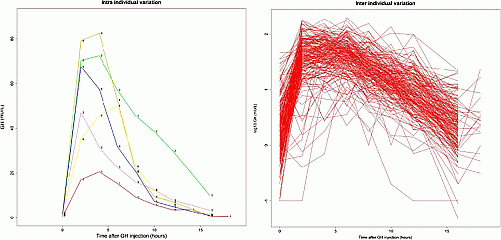ESPE2015 Poster Category 3 GH & IGF (68 abstracts)
As Great Intra as Interindividual Variability in Uptake of s.c. GH Injections in Longitudinally Followed GH Treated Children
Elena Lundberg a , Berit Kriström a , Björn Andersson b , Sten Rosberg b & Kerstin Albertsson-Wikland c
aDepartment of Pediatrics, Institute of Clinical Sciences, Umeå University, Umeå, Sweden; bDepartment of Pediatrics, Göteborg Pediatric Growth Research Center, Institute of Clinical Sciences, Sahlgrenska Academy at the University of Gothenburg, Sweden, Göteborg, Sweden; cDepartment of Physiology/Endocrinology, Institute of Neuroscience and Physiology, The Sahlgrenska Academy at the University of Gothenburg, Göteborg, Sweden, Göteborg, Sweden
Background: The variation in uptake of daily sc GH-injections is hardly known.
Objective and hypotheses: There is a considerable variability in uptake of s.c. GH-injections both within and between children.
Method: 65 children used (Genotropin® pen 4/16, needle 12 mm), dose 0.08–0.14 mU/kg per day within trials: TRN 87–010; 88–080; 88–177; followed yearly two–eight times 1992–1999 (n=214). GHserum-sampling every 2nd h, before and until 16 h after the s.c. GHinj at 18.00 h, given by patient/parent under nurses’ supervision: 90° deep sc in femoral muscle. GH was analysed by Pharmacia Polyclonal assay, IRP 80–505, with CV 10%. Pharmacokinetic estimates were Tmax (h), Cmax (ug/l), AUC 16 h. The GH-curves divided into group A: back-to-baseline within 16 h (n=46), group B: did not return (n=70), group C: suspected GHpeak from endogenous secretion (n=74). Values given as median (coefficient of variation, CV %).
Results: Interindividual variation: group A: with Cmax 64 (45) at Tmax 4 (42), AUC1 6 h 407 (40) and back-to-baseline after 16 h (43). Group B: Cmax 61 (50), Tmax 4 (38), AUC 16 h 420 (40). Group C: Cmax 60 (56), Tmax 4 (60), AUC 16 h 431 (52). Intra-individual variation: group A+B+C: 51 subjects with 2–8 times=190 curves: Cmax 63 (36), Tmax 4 (41), AUC 16 h 426 (32).
Conclusion: As great intra and inter-individual variability in GH uptake from s.c. injection was found. The impact on growth and IGF1 response remains to be elucidated.
Funding: These investigator-initiated and sponsored studies (TRN 88-080; TRN 88-177; TRN 89-071; TRN 98-0198-003) were supported by unrestricted research grants from Pharmacia/Pfizer, the Swedish Research Council grant no 7509, the Foundation Växthuset for Children, Sahlgrenska University Hospital (ALF), West Sweden Region (VGR) grants, and the County Council of Östergötland.

 }
}



